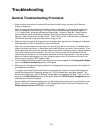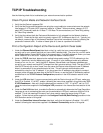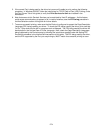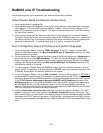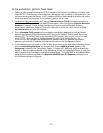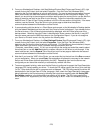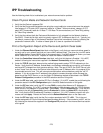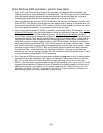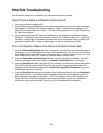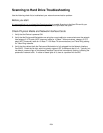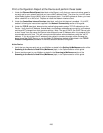278
5. From your Workstation's Desktop, click Start/Settings/Printers (Start/Printers and Faxes in XP), right
mouse click on the Printer's icon and select Properties. From the Ports Tab (Windows 2000)
determine the Port that the driver is using to print through. For peer to peer communications, the port
name should match the SMB Host name of the Device as shown on the Configuration Report. If it
doesn't you are printing to the wrong port and either need to select the correct port or use the Add Port
button to create a new port for the driver to print through. Follow the instructions supplied in the
NetBIOS over IP Peer to Peer Printing procedure in the Print Drivers section of this guide. If the name
matches, use the General Tab of the driver to print a test page to determine the status of
communications between the Workstation and the Device.
6. If communicating with the device in a Client/Server environment, at the Workstation's Desktop double
click the Network Neighborhood icon and see if the Printer's Server is displayed. If you double click on
the Server's name, a list of Shared printers should be displayed, with the Printer being one of the
devices shown. Note that since the Printer is identified as a Share name on the Server, it may NOT
have the same name as the SMB Host name on the Configuration Report. If you do not recognize
your Server or Printer's name in the list, perform the following step.
7. From your Workstation's Desktop, click Start/Settings/Printers (Start/Printers and Faxes in XP), right
mouse click on the Printer's icon and select Properties. From the Ports Tab (Windows 2000)
determine the Port that the driver is using to print through. For Client/Server communications, the port
name should be in the form of a UNC (universal naming convention) such as
\\Computer_name\Share_name. If it isn't you are printing to the wrong port and either need to select
the correct port or use the Add Port button to create a new port for the driver to print through. If the
name looks correct, use the General Tab of the driver to print a test page to determine the status of
communications between the Workstation and the Device.
8. Note that if you have the "UNC" of the Printer, you can enter this into the text box of the Run command
on your workstation. When you press Enter, the workstation will attempt to reconnect to the network
Server and Printer Share that was specified by the UNC. Depending upon how the Server was
configured you can then either manually or automatically reinstall the driver.
9. To assure successful printing, make sure that the Device is configured to support the Page Description
Language (PDL) being used by your driver. To check the PDL being used by the driver, print a test job
"to file." Open and view the job in a program such as Notepad. The PDL being used by the driver will
be displayed in the first few lines of Printer Language. Next, check the Page Description Languages
being supported by the Device's ports by following the instructions supplied under the Setting PDL
Emulations procedure in the Internet Services section of this guide. The PDL being used by the
driver, and the PDL supported by the Port you are printing to, MUST match for successful printing to
occur.



